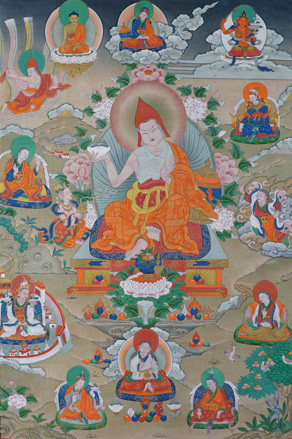Guru Padmasambhava: Difference between revisions
Jump to navigation
Jump to search
No edit summary |
mNo edit summary |
||
| (3 intermediate revisions by one other user not shown) | |||
| Line 1: | Line 1: | ||
[[Image:Padmasambhava.jpg|frame|Guru Padmasambhava]] | [[Image:Padmasambhava.jpg|frame|Guru Padmasambhava]] | ||
'''Guru Padmasambhava''' (Skt.) is actually the specific name of one of the [[Eight Manifestations of Guru Rinpoche]]. However, the name [[Padmasambhava]] now | '''Guru Padmasambhava''' (Skt.; Tib. [[གུ་རུ་པདྨ་འབྱུང་གནས་]], [[Wyl.]] ''gu ru pad+ma 'byung gnas'', Eng. ‘Lotus-born’) is actually the specific name of one of the [[Eight Manifestations of Guru Rinpoche]]. However, the name [[Padmasambhava]] now commonly refers to all the iconographical aspects of [[Guru Rinpoche]]. As one of the Eight Manifestations, Guru Padmasambhava is most often depicted as a [[pandita]] wearing monks robes, holding a [[kapala]] in his right hand and performing the vitarka [[mudra]] with his left hand. | ||
==References== | ==References== | ||
Latest revision as of 03:56, 21 July 2017

Guru Padmasambhava (Skt.; Tib. གུ་རུ་པདྨ་འབྱུང་གནས་, Wyl. gu ru pad+ma 'byung gnas, Eng. ‘Lotus-born’) is actually the specific name of one of the Eight Manifestations of Guru Rinpoche. However, the name Padmasambhava now commonly refers to all the iconographical aspects of Guru Rinpoche. As one of the Eight Manifestations, Guru Padmasambhava is most often depicted as a pandita wearing monks robes, holding a kapala in his right hand and performing the vitarka mudra with his left hand.
References
- Phillippe Cornu, Dictionnaire Encyclopédique du Bouddhisme, page 419.
- Chögyam Trungpa, Crazy Wisdom, The Collected Works of Chögyam Trungpa, Volume Five (Boston & London: Shambhala, 2004), page 123.
Further Reading
- Chögyam Trungpa, Crazy Wisdom, The Collected Works of Chögyam Trungpa, Volume Five (Boston & London: Shambhala, 2004), pages 123-133.